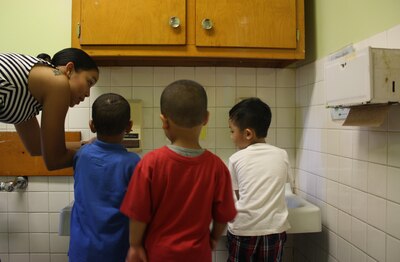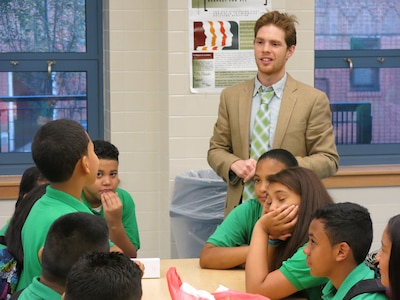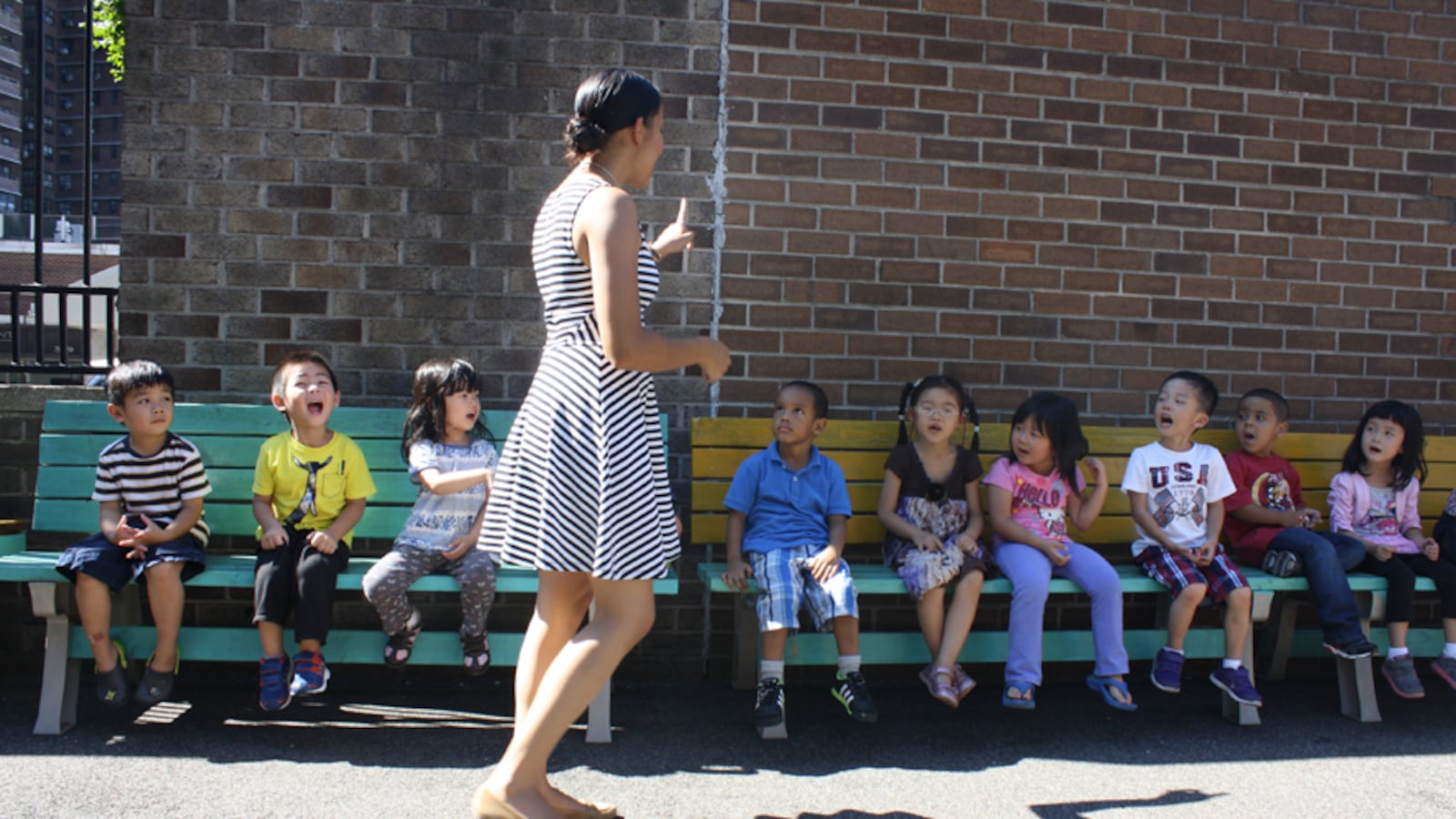When Kelly Eng tried to enroll her daughter in pre-kindergarten this summer, she found that all of the spots at P.S. 229 in Brooklyn were full. The same was true at nearby P.S. 748 and at local community-based organizations. So Eng widened her search to Manhattan, where—a few waitlists later—she found an opening at Grand Street Settlement in Chinatown.
It’s at least an hour-long commute from their Dyker Heights home but she’s happy to have it. “I feel lucky,” Eng said as she filled out forms on a child-size chair on Thursday morning.
Mayor Bill de Blasio undoubtedly does too. City officials said more than 51,500 children had signed up for full-day pre-K starting this week in schools and community organizations like Grand Street, approaching the city’s goal of 53,000 and nearly doubling the number in those programs last year. And day one went off mostly without a hitch.
“This is a moment of fulfillment, a dream we’ve had for a long time finally coming to fruition,” de Blasio said at Inner Force Tots, a pre-K site in Brooklyn on Thursday morning.
This year, the city is also beginning an expansion of after-school programs and “community schools” with additional social services for students and the broader neighborhood. But the pre-K initiative is the most complicated education undertaking the city has begun, and the mayor’s five-borough celebratory tour on Thursday focused on pre-K after months of intense scrutiny and inter-agency coordination.
To double and triple check that all sites were up to code, the departments of buildings, health, fire and education conducted about 6,000 inspections and walk-throughs. And, in August, the city offered an optional free training for more than 4,000 teachers to go over a Common Core-aligned curriculum and share best practices with one another.

The fast-track process did include some hiccups. Nine pre-K sites had their permits revoked this week, and 14 won’t open until next Monday. City officials said they expect another 22 to open in the near future, after being delayed for safety or permitting issues. Questions have continued to be raised about the quality of those walk-throughs and the thoroughness of the teacher training.
On the first day of school, de Blasio and Schools Chancellor Carmen Fariña visited schools with pre-K, including Journey Prep School in the Bronx, and Home Sweet Home Children’s School in Queens, and Inner Force Tots, where Fariña again defended the quality of the site inspections.
“I don’t think we’ve ever had as many walk-throughs in the New York City education department as we did this year,” Fariña said.
Back at Grand Street Settlement, the children may have thought they were just playing games as they pulled on doctor and police officer outfits and built train tracks on the carpet. But teachers said they were also learning specific skills like communication and literacy.
“A lot of parents expect a rigorous program,” said Khadija Prowell, pre-K teacher at Grand Street. “They want to know, ‘What is my child learning?’ and ‘Why is my child not writing after three weeks?’” Prowell laughs. “It’s harder to explain to parents.”
At the city-sponsored training in August, Bank Street College of Education trainers advocated for seeing play time as learning time, and allowing for “free choice time,” as opposed to scheduling activities the entire day.
During “free choice time” at Grand Street, two children pretended to shop at a store. One of them was Abdul Ortega, whose parents hoped that he would become more communicative around his peers since he was not very verbal at home. As he played, Ortega took a doll in a white lace dress out of a shopping cart and put his red-haired doll in its place. Catori Chen, who had claimed the doll in lace, saw this and got upset.
“That’s my baby,” she said, apple-cheeked and pouty. “I looked away and he took it.”
Ortega stood there for a moment. Then he wordlessly took his doll out of the cart and replaced it with hers. Shopping commenced. There would be many other days to expand his language skills. Today, he could start with making a new friend.
A second major undertaking
Mayor de Blasio’s second major educational initiative is to expand after-school programs in middle schools, with the goal of offering all sixth, seventh, and eighth graders access to after-school programming at schools or community-based organizations by the end of next school year.
At the Highbridge Green School, a new middle school in the South Bronx, Principal Kyle Brillante plans to continue weaving together the school’s normal day and its after-school program, in line with the goals of the de Blasio administration’s expansion and the latest research on “expanded learning time.”
That was obvious Thursday morning, when Brillante told the new sixth-grade students that the school day ends at 5:10 p.m., which is technically when the after-school program wraps up.

To ensure that the students’ longer days are well spent, some classroom teachers stick around to tutor students or work with small groups. The after-school staff sometimes trains alongside the school faculty and analyzes student data with them — collaboration that should become more frequent with the weekly professional development time built into the new teachers contract, Brillante said.
Using funds from the after-school initiative, Brillante hopes to offer yoga, debate club, and coding instruction this year. The city anticipates that the number of middle schools offering after-school programs will jump from 231 to 562 this year, and how those schools succeed at developing their own programs—and recruiting the middle school students to take part—will be a major test for the de Blasio administration.
On Thursday morning, as Ralph Lawrence dropped off his son, Lamar, at the school, he said he felt good knowing that the students would remain in the building even after classes ended that afternoon.
“They’re off the streets and they’re learning,” Lawrence said. “They need that.”


